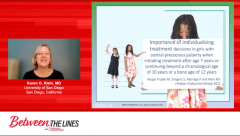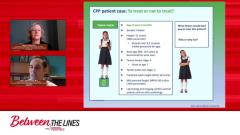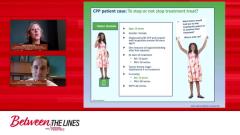
CPP Patient Case: When to Treat
Karen O. Klein, MD, and Kent L. Reifschneider, MD, discuss a central precocious puberty (CPP) patient case regarding factors that would lead a physician to treat a patient.
Episodes in this series
Karen O. Klein, MD: So let’s look at Sophia. She’s 8 years, 4 months, currently 51 inches, which is 50th percentile for her age. She’s growing at 8.5 centimeters a year, which is greater than the 99th percentile for her current age. And her bone age is 10 and half. She’s Tanner stage 3 for breasts. When you go back in the history, the family thinks probably her breast started around 7. She also has Tanner stage 3 pubic hair. Right now, with her bone age of 10 and a half and her current height, she predicts to reach a final height about 58 inches. Her midparental height based on mom and dad and correcting for gender is 66 inches. All of her lab testing imaging confirms central precocious puberty, idiopathic central precocious puberty. No other etiology or pathologies are found. And so what things would you highlight as you look at this description to decide whether to treat her or not?
Kent L. Reifschneider, MD: Well, I think the points that you made in your presentation in the article are dead-on that you can get a little bit of insight here. One is the degree of bone age maturation already noted at this point in time is pretty significant. And of course, that’s correlating with a compromise in adult—predicted adult height. So you have a sense of the tempo here. Number 2, 1 of the things that I think that people might forget to think about is that bone age, there’s still a little bit of delay between what’s really going on in the body and its impact on the bone maturation. So although at this point in time, it’s 10 and a half, reality is that momentum is still ongoing. So even if I was able to wave or initiate therapy immediately right now, there’s still going to be some lingering acceleration before it slows down. And so this person clearly meets the criteria in my mind to treat therapy, to initiate therapy. I think the challenges is the back end. What are you going to say to the families? Well, how long do you think we’re going to treat her? And for me, my personal impressions, I want to say this person’s going to be treated for some time because of the reasons I just mentioned, but I love your insight.
Karen O. Klein, MD: So let’s come back to the how long part of the discussion in a few minutes, but let’s make a couple other points. One of which, as we talk to our colleagues around the country and the world, let me just pretend I’m someone else for a minute and get your response. But Dr. Reifschneider, this patient’s already 8 and a half, basically. I was trained to treat children if they have pubertal onset before age 8. Why do you even want me to think about treating her just based on that age question?
Kent L. Reifschneider, MD: That’s a great question, and I think this is where we talk about the uniqueness in individual medicine. We are treating an individual. We’re not treating a lab or chronological age. And so 1 of the things here that helps you to kind of get a sense of the tempo is that the parents report the onset of breast tissue at 7 years of age. And so if we were going to use the classic definition, then just history itself helps you to kind of say yes, they meet that criteria, right? And then that’s further validated by 2 other important what I call objective data. The growth velocity is greater than prepubertal, and the bones at this 1 point in time are quite considerably advanced.
Karen O. Klein, MD: That’s great. I think it’s so important to make the point that just because you meet them after age 8, you need to look back in history. Thank you. And then what would the benefits be to treatment? What are you going to tell the parent why we’re even considering treating?
Kent L. Reifschneider, MD: Well, that’s a great question because sometimes these individuals are like—are often elite athletes in elementary school or middle school in basketball specifically because they’re tall, right? But then when we have the conversation of the outcomes, it should not intervene. That, “Hey look, although she stands out at this point in time, the repercussions on the backend are pretty profound because she is really 10 and a half, at least on the inside, probably 11 plus that she’s going to stop growing if we assume normal speed within the next few years.” And then what’s going to happen is all of her peers are going to wind up growing right past her. She’ll wind up actually way below where we’d expect her to be based on her family as well as her peers. And we can demonstrate that to some degree based on the predicted or calculated adult height.
Karen O. Klein, MD: That is so great and makes such a good point that’s so confusing to families when their child is so tall, and we’re saying we’re worried about them being too short. So thank you for walking us through that carefully. And of course, we also want to emphasize that, you know, she’s in the middle of puberty, so menarche is around the corner. And if she’s only 8 years old, that would be very early for menarche to start in the next 6 months, potentially. We can’t know for sure. So let’s get back now to your question of how long should we anticipate with the family that she’s going to need treatment. And, you know, 1 of the ways I like to think about it to make it a visual for the family, you very nicely just said really we can think of her body like a 10 and a half or 11-year-old, so we can think of her growth that way as well. As we start treatment, we’re going to slow down the rate of progression of those bones. Now they’re not going to just stop, but our goal is if we start treatment now, her bones are 2 years ahead. A year from now, her bones won’t still be 2 years ahead. We’ll have denarrowed that gap some between her chronological age and her bone age. So you can sort of think of it as to grow typically you would need to catch up to your bone age, right?
Kent L. Reifschneider, MD: Right.
Karen O. Klein, MD: And like how you mentioned, we want to treat her past when her peers have caught up to her because she’s going to accelerate as soon as we stop treatment. And so if we think of, like, ideally, we catch up to her bone age, now the bone age, since it’s not going to hold still and is going to continue to advance, we already know that’s at least 2 years in her.
Kent L. Reifschneider, MD: Exactly.
Karen O. Klein, MD: It’s going to be more than 2 years. And we’re going to talk about another case in a minute when we look at that other end of the spectrum that will help us tease out some of those factors. But just looking at her, you would say she needs 2 to 3 years of treatment.
Kent L. Reifschneider, MD: I’m in agreement absolutely. And again, that article that you guys presented is it did as good a job as you possibly can to try to clarify the gray zone on the front end and the back end. And I think this case study does a great job of kind of helping to depict the gray zone on the front end as to when to treat versus not. Just because she’s almost 8 and a half chronologically she clearly meets the criteria for central precocious puberty, uh, based on history and bone advancement. But the other thing is we have a little bit of an insight and tempo, but my suspicion is tempo is also perhaps accelerated so that further compromises the predicted adult height. And so I think that your article did a great job highlighting these points, and I look forward to discussing the back end with—I think you have another case where we can talk about when do we stop therapy?
Karen O. Klein, MD: Yes. One more question about Sophia and then we’ll go to the next case. What considerations should be made regarding monitoring during treatments so that Sophia has the optimal results from this treatment?
Kent L. Reifschneider, MD: So I think that’s an excellent question. And I often ask my colleagues how often you see your growth-related kids? Do you see them every 4 months? Do you see them 6 months? And knowing that we’re all so very, very busy, it’s often, well, ideally, I’d like to see them 4 months, 3 or 4 months, but the reality is probably 50/50, 4 months versus 6 months, depending on your backlog on new patient referrals. But for her, I’d like to see the initiation of therapy. I’d certainly like to follow every 4 months until I get a better appreciation of the tempo, and then once I see the tempo has declined into more of a pre-pubertal, then I kind of go into conceptually a maintenance biannual screening with once a year bone age, watching that predicted height improve and get closer and closer to the midparental height, which is really our goal here. It’s to help with the psychological kind of disparities, but also to help get them closer to where they were supposed to be. Is that your approach as well?
Karen O. Klein, MD: Yes. So I think the general things are we need to continue to watch the physical exam, exactly what you said that the rate of clinical progression of puberty is slowing down. We want to do some hormonal measurements early on to make sure that we can show some hormonal suppression. And then yes, once a year bone age just to show that the rate of bone maturation has decreased and that we are improving predicted adult height. And we can use that to help decide the end of treatment, which leads us to our next case.
Newsletter
Access practical, evidence-based guidance to support better care for our youngest patients. Join our email list for the latest clinical updates.








